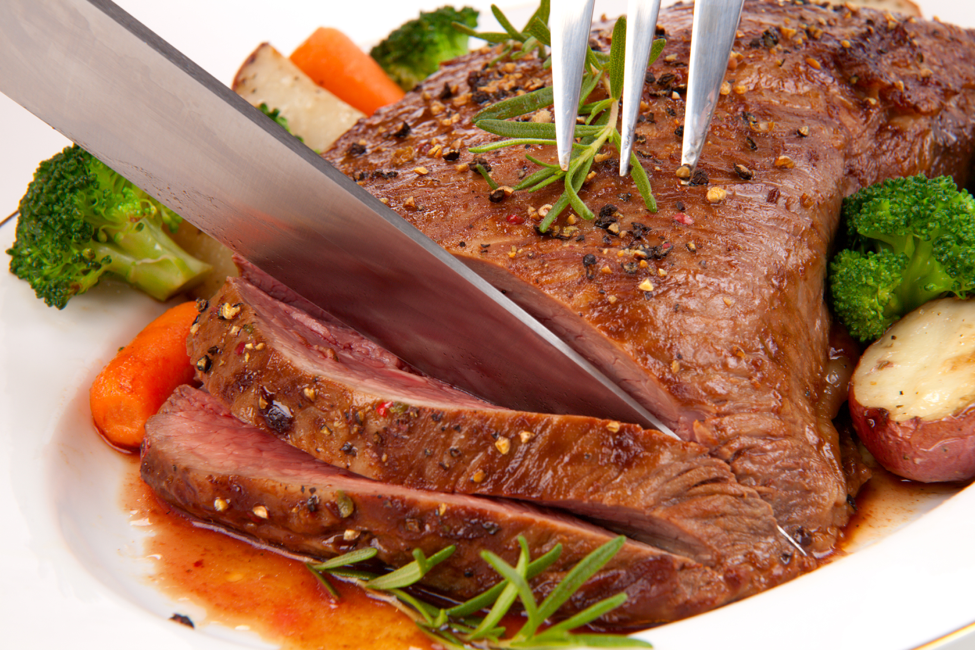We’ve all been told for decades that red meat causes heart disease and increases mortality because it contains saturated fat. This is a fallacy created by poor research, incorrect reporting and media fear-mongering. Many have paid a dear price in their health as a result. Red meat is essential for optimum health.
A large group of people express fears about red meat or boast about their vegetarian achievements. Book after book is quoted telling the public about how red meat causes disease, verifying fears. Red meat is unhealthy, even toxic!
Over the past few decades, red meat has been increasingly blamed for everything from heart disease to cancer and certain early death. Newspapers and magazines incessantly post headlines about the negative health ramifications of eating red meat, fueling consumer fears. These front page claims could not be further from the truth.
Studies that differentiate between processed and fresh red meat have failed to find a link between unprocessed red meat consumption and heart disease. A major Harvard University study of meat eaters found that only processed meat had an adverse risk in relation to coronary heart disease.
As a species, humans have eaten red meat for millions of years. How could red meat have become deadly in the last 50 years? We have been fed inaccuracies fuelled by faulty research. It is vitally important to reveal the truth about red meat. An impartial review of the research indicates that red meat is one of the healthiest foods you can eat.
Many of the health benefits discussed are not unique to red meat, but apply to animal flesh in general. Muscle meats are the most nutritious food (after organ meats) based upon our biological needs, according to the Kraken Index of Nutrients that rate the nutrient density of food (developed by Dr.Mat LaLonde). Dr LaLonde, a biochemist and Harvard researcher, ranked foods according to essential nutrients that we must eat from the diet because the body cannot make them itself. Vegetables come in after muscle meat. Please keep in mind that the graphic below represents food groups as a whole. Some plant foods (including kale and blueberries) rate as high as muscle meats. Below is a breakdown of the most nutritious foods to the least nutritious according to the Kraken Index of Nutrients:
- Organ Meats
- Muscle Meats
- Vegetables
- Fruits
- Grains
- Refined sugars
Red meat is one of the healthiest foods one can eat. To qualify, red meat needs to be grass fed (or pastured) and organic to confer the most nutrition to the animal. Cows, bison, lamb and other ruminants that eat only grass (their natural diet) produce meat that is much more nutritious. Most people eat red meat that is only fed grains, at best, and GMO corn and soy at worst. This has an effect on the fatty acid profile present in the muscle.
Red meat is one of the most nutritious foods you can eat, containing one of the most abundant dietary sources of vitamins D and B12, iron and zinc, along with many other essential nutrients. To prevent deficiencies in these nutrients, red meat should be eaten at least once a week, although eating it two to three times a week is ideal and most beneficial. The following classify as red meat:
- Beef
- Bison
- Deer
- Duck
- Elk
- Goat
- Goose
- Horse
- Lamb
- Moose
- Mutton
- Pork
Vitamin D
In northern climates, studies show that over 50% of the population is vitamin D deficient, going up in the winter months. If oily fish consumption is less than 2 to 3 servings per week, red meat can assist meeting your vitamin D requirements. In climates where adequate vitamin D cannot be obtained from the sun, meat has been shown to be protective against rickets, a softening of the bones caused by severe vitamin D deficiency. Red meat contains a form of vitamin D called 25-hydroxycholecalciferol, which is assimilated much easier than other forms of vitamin D. Milk consumption with the same levels of vitamin D does not provide the same protection, indicating that the vitamin D in meat is uniquely absorbable and useful to the human body.
Iron
Red meat contains primarily heme iron, the form that is absorbed much more efficiently than the non-heme form of iron found in plant foods. The body struggles to absorb non-heme iron, yet small amounts of meat can aid in the absorption of this plant based iron. Non-heme iron is found in spinach and tofu, but little is absorbed because phytates in these foods bind to it and prevent absorption.
Red meat consumption is particularly important for women who are pregnant or trying to conceive, as iron is crucial for the growth and development of the fetal brain.
If you have iron-deficiency anemia it is always better to replenish with the iron from red meat due to its ease of absorption. Whole food sources are always better options than supplementation. Furthermore, iron supplements are not recommended as they can build up to toxic levels in the liver and cause constipation and the ionic forms found in most supplements are not well-absorbed.
B Vitamins
Red meat is a rich source of vitamin B12, vital to the functioning of a majority of systems in the body, especially your nervous system. B12 deficiencies can play a role in everything from aging to cancer, heart disease, and infertility. The main function of B12 is to support the nervous system while maintaining healthy brain chemistry and synthesizing neurotransmitters like dopamine and serotonin. These govern mood, energy, sleep, appetite, drive, motivation, movement, cognition and numerous other brain functions.
Even though it is present in abundance, B12, can be difficult to absorb from red meat. Digestive strength needs to be ensured by healing adrenal fatigue, (which causes low stomach acid), avoiding over-the-counter and prescription antacids and proton pump inhibitors. Taking supplemental hydrochloric acid (HCL) with pepsin may be needed. Adequate stomach acid is essential for health to break down and absorb all nutrients, not just those in red meat.
Red meat also contains significant levels of other B vitamins, including thiamin, riboflavin, pantothenic acid, folate, niacin, and vitamin B6. Red meat is one of the easiest ways to ensure adequate intake of your B vitamins.
Zinc
Red meat is an especially important source of zinc. Many people are zinc deficient, but vegetarians run a greater risk of zinc deficiency. Zinc is an essential mineral that is an imperative part of body functioning, including structure in many proteins and enzymes and regulation of gene expression. Zinc is used to repair damage in our arteries. If zinc is not readily available for arterial repair, they must either absorb a toxic heavy metal called cadmium to do the repair or our liver must make cholesterol to repair them. As with vitamin D and iron, the zinc present in red meat is highly bioavailable, meaning it is easy to absorb and assimilate.
Mineral-rich
Red meat contains significant levels of other vital minerals such as magnesium, copper, cobalt, phosphorus, chromium, nickel, and selenium. Minerals have become increasingly scarce in our diet thanks to intensive farming methods, avoiding the use of mineral-rich manure to fertilize crops and the use of depleting superphosphate fertilizers, which contain only three minerals (nitrogen, phosphate and potassium – NPK). Due to the scarcity of minerals in our food supply, it is very important to eat as many mineral rich foods as possible.
The best argument for the consumption of grass fed red meat comes due to its fatty acid profile. Grass fed meats contain approximately equal parts of saturated and monounsaturated fat, with only a small amount of polyunsaturated fat. Contrary to popular belief, the body requires the consumption of saturated fats. Not all saturated fats are unhealthy. There are many healthy saturated fats found naturally. Unhealthy saturated fats tend to be produced and processed. In order for the body to maintain the ability to absorb minerals from foods, 50% of dietary fats need to be saturated.
We evolved as a species due to our eating red meat. It follows that we need it to enjoy optimum health. Our bodies were designed to function on the nutrients in red meat. It is important to note how the meat was raised and fed.Grass fed red is biochemically different, does not contribute disease and promoted optimal health.





Leave A Comment